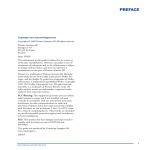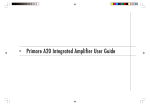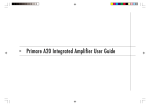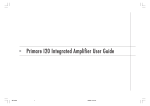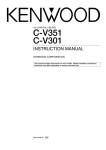Download Primare P30 User guide
Transcript
>
Primare P30 Processor User Guide
i
>
Preface
COPYRIGHT AND ACKNOWLEDGMENTS
Copyright © 2000 Primare Systems AB. All rights reserved.
energy and if not installed and used correctly in accordance with our
instructions may cause interference to radio communications or radio and
Primare Systems AB
television reception. It has been type-tested and complies with the limits set out
Idavägen 5
in Subpart J, Part 15 of FCC rules for a Class B computing device. These limits
SE-352 46 Växjö
are intended to provide reasonable protection against such interference in
Sweden
home installations.
The information in this guide is believed to be correct as of the date of
EEC: This product has been designed and type-tested to comply with the limits
publication. However, our policy is one of continuous development and so the
set out in EN55013 and EN55020.
information is subject to change without notice, and does not represent a
commitment on the part of Primare Systems AB.
Primare is a trademark of Primare Systems AB. Manufactured under license
from Dolby Laboratories Dolby, Pro Logic, and the double-D symbol are
trademarks of Dolby Laboratories. Confidential Unpublished Works. Copyright
1992-1997 Dolby Laboratories, Inc. All rights reserved. LaserDisc is a
trademark of Pioneer Electric Corp. All other product names are trademarks or
registered trademarks of their respective owners.
ii
FCC Warning: This equipment generates and can radiate radio frequency
This guide was produced by Human-Computer Interface Ltd,
http://www.interface.co.uk
>
Contents
Introduction
W E L C O M E T O T H E P 3 0 P R O C E S S O R ............
Advanced use
(1
USING THE P30 WITH OTHER PRIMARE
U S I N G T H E M A I N M E N U ....................................
(9
C H O O S I N G T H E S U R R O U N D M O D E ..............
{10
P R O D U C T S ................................................................
(2
M A K I N G R E C O R D I N G S ........................................
{11
T E C H N I C A L S P E C I F I C A T I O N .............................
(2
L A T E N I G H T M O D E ................................................
{12
L O C K I N G T H E F R O N T P A N E L ............................
{12
Using the P30 Processor
Connecting the P30 Processor
F R O N T P A N E L C O N T R O L S ..................................
(3
F R O N T P A N E L D I S P L A Y .........................................
(4
B A C K P A N E L C O N N E C T I O N S ...........................
{13
S W I T C H I N G O N A N D O F F ................................
(4
M A I N O U T P U T S ......................................................
{14
S E L E C T I N G A S O U R C E ........................................
(5
A U D I O I N P U T S ........................................................
{14
C H A N G I N G T H E V O L U M E ..................................
(6
V I D E O C O N N E C T I O N S .......................................
{14
R E C O R D O U T P U T S .................................................
{15
{15
CHANGING THE BALANCE, CENTER,
R E A R , A N D S U B W O O F E R L E V E L S ....................
(6
M I C R O P H O N E , D A T A A N D R S 2 3 2 ..................
L A T E N I G H T M O D E ................................................
(7
CONNECTING TO THE PRIMARE A30.5
M U L T I - C H A N N E L A M P L I F I E R ...............................
{15
CONNECTING TO THE PRIMARE V20 DVD
P L A Y E R ........................................................................
{15}
iii
>
Preface
Setting up the speakers
Saving the configuration
C O N F I G U R I N G T H E S P E A K E R S ........................
{17
S E T T I N G T H E S P E A K E R D E L A Y S ........................
{19
S E T T I N G T H E S P E A K E R L E V E L S .........................
{20
S E T T I N G T H E S P E A K E R P H A S E S .......................
{22
Setting up the sources
S T A N D A R D S O U R C E S ...........................................
{23
R E M O V I N G A S O U R C E ........................................
{24
E D I T I N G A S O U R C E ..............................................
{25
E X A M P L E S O F S O U R C E S .....................................
{26
Configuring the display
CONFIGURING THE ON-SCREEN
D I S P L A Y ......................................................................
{27
C O N F I G U R I N G T H E F R O N T PA N E L
D I S P L A Y ......................................................................
iv
{28
I N T R O D U C T I O N ......................................................
Index
{29
>
Introduction
Welcome to the Primare P30 Processor! This chapter introduces you to its key
features, and explains how you can take advantage of its configurability to
create a system perfectly suited to your requirements.
WELCOME TO THE P30 PROCESSOR
The P30 provides a comprehensive range of features to make it ideal as the
heart of a superb music or home entertainment system:
Full configurability
The P30 is fully configurable, using a simple set of on-screen menus, to allow
you to set it up with the exact combination of sources and outputs that you
want to use for your own system. The P30 is supplied already set up with a
Flexible range of inputs
standard set of sources, designed to cater for the most usual combination of
The P30 provides a range of inputs flexible enough to cater for virtually any
inputs and outputs in a typical system, but you can modify these or define your
combination of sources including: seven analog phono inputs, one analog
own sources with total flexibility.
balanced input, five coaxial digital inputs, two TOSlink optical digital inputs,
and one AES/EBU balanced digital input.
Intuitive user interface
In keeping with the philosophy of the Primare range of systems, the P30’s
Video switching
powerful range of features can be controlled through a very simple and
The P30 provides four composite video inputs and three S-Video inputs to
intuitive interface, designed so that it will not distract you from the pleasure of
allow you to switch up to seven audio-visual sources.
listening to music or watching movies on your system.
Digital Surround Processing
In fact almost all the features of the P30 can be accessed through just two front
The P30 can decode multi-channel sources encoded in either Dolby Pro Logic,
panel controls and four push buttons; alternatively the same degree of control
or Dolby Digital (AC-3), to provide six discrete output channels for up to six
is provided through the remote control supplied with the P30.
loudspeakers in a surround system.
Bypass mode
The P30 provides a Bypass mode, which bypasses the digital processing
stages for the purest possible reproduction of conventional two-channel music
sources.
1
>
Introduction
Easy to set up
The P30 is also exceptionally easy to set up for a perfectly balanced surround
sound. Simply plug a microphone into the appropriate P30 input, and position
it at the listening position. The built-in calibration test will then balance the level
of each output to give a correct sound image for your system and the room
you are listening in.
USING THE P30 WITH OTHER PRIMARE PRODUCTS
Although the P30 is flexible enough to work with virtually any other equipment
you have in your system, it is ideal for use with the other products in the
Primare range, including the Primare A30.5 Multi-Channel Amplifier and the
Primare V20 DVD Player. A particular benefit of using the P30 with the Primare
T E C H N I C A L S P E C I F I C AT I O N
Analogue inputs
1 balanced, 7 RCA.
Digital inputs
1 balanced, 5 coax, 1 TOSlink.
Video inputs
2 composite, 3 S-Video.
Balanced analogue outputs
Front left and right
Analogue outputs
Rear left and right, center and sub.
Record
Analogue, 1 coax. 1 TOSlink
2 composite, 2 S-Video
Modes
Dolby Digital, Dolby Pro Logic, Music surround, DTS.
Calibration
Automatic or manual with calibration microphone.
Video
NTSC/PAL, S-Video and composite.
DVD Player is that you can control both units with the single remote control, to
Analogue data
give you a fully integrated system with the simplest possible user interface.
Bandwith
1Hz – 100kHz, -1dB
THD
<0.005%, 20Hz-20kHz
Signal-to-noise
-110dB
Frequency response
<10Hz – 100kHz, -1dB
Input impedance
15kΩ, unbalanced
10kΩ, balanced
Output impedance
50Ω
Digital data
Frequency response
2
20Hz – 20kHz, ±0.2dB
THD+noise
0.005% @1kHz
Dimensions (WxDxH)
430 x 385 x 100mm
Weight
10kg
>
Using the P30 Processor
This chapter explains how to operate the P30 Processor, using either the front
panel controls or the direct remote control commands.
F R O N T PA N E L C O N T R O L S
]C The NIGHT button selects late night listening mode.
Almost all the functions of the P30 Processor can be accessed using the two
]D The LEVEL button selects which setting you change with the VOLUME
control.
front panel controls and four push buttons, and information about its operation
is displayed on the front panel display:
]E The STANDBY button mutes the sound. Holding it down switches the
P30 to standby.
]A The INPUT SELECTOR control selects which input you want to listen to
or watch.
]F The VOLUME control changes the volume, or a setting selected with the
LEVEL button.
]B The DIM button dims the front panel display.
INPUT SELECTOR
VOLUME
57
AC-3
VOLUME
DVD
P.L
DIM
NIGHT
LEVEL
STANDBY
]B
]C
]D
]E
P30 PROCESSOR
]A
]F
3
>
Using the P30 Processor
F R O N T PA N E L D I S P L AY
SWITCHING ON AND OFF
The following illustration shows the information on the front panel display:
To switch on
]A
]B
]C
]D
]E
• Use the switch under the left-hand edge of the front panel.
During normal operation you can leave the P30 switched on and in standby.
To switch to standby
57
AC-3
VOLUME
DVD
DTS
MPEG
P.L
]F
]A Volume setting.
]B AC-3 or Dolby D indicates that a Dolby Digital input is present.
]C DTS indicates that a DTS input is present.
]D MPEG indicates that an MPEG input is present.
]E P.L indicates that the digital input is 2-channel Pro Logic.
]F Currently selected input, Mute, or level setting.
To dim the front panel display
• Press the DIM button on the front panel or remote control.
The display will dim to a single bar. The normal display will reappear while
you adjust any settings.
4
• Hold down the STANDBY button on the front panel or the STBY button
on the remote control.
Using the P30 Processor
<
To select a source
SELECTING A SOURCE
The P30 Processor allows you to define up to 16 sources, eight digital and
eight analog, and any source can be combined with one of the video inputs.
When the P30 Processor is first supplied the standard sources shown below
• Turn the INPUT SELECTOR control on the front panel until the name of the
source is shown on the front panel display.
46
For example:
are already set up for you.
VOLUME
You can simply disable any of these sources that you do not need; see
Removing a source, page 24. You can also change any source to use different
inputs, or configure your own sources with any name you choose and using
any particular inputs as appropriate for the source.
Video
AC-3
P.L
Tuner
• Alternatively, press the SEL A or SEL V buttons on the remote control to
step between sources.
The current source is also shown on the on-screen display.
Source
Audio
Surround mode
Description
CD
Analog
None
Bypass
High quality CD player
DVD
Digital
S-Video
PCM 2-CH
DVD player
TapeD
Digital
None
Pro Logic
Digital tape recorder or minidisc player
Laser
Digital
S-Video
PCM 2-CH
LaserDisc player
Tuner
Analog
None
Stereo
FM radio tuner
TV
Analog
Video
Pro Logic
Television or monitor
TapeA
Analog
None
Stereo
Analog tape output
Sat
Analog
Video
Pro Logic
Satellite receiver
5
>
Using the P30 Processor
CHANGING THE VOLUME
The P30 allows you to vary the volume from 0 (silence) to 99 (maximum
volume), where each step is equivalent to 0.5dB.
To change the volume
• Rotate the VOLUME control on the front panel, or press the VOL A or
VOL V buttons on the remote control.
The current volume setting is shown on the front panel and on-screen displays:
CHANGING THE BALANCE, CENTER, REAR, AND
SUBWOOFER LEVELS
You can independently change the balance, center level, rear levels, and
subwoofer level to alter the balance of sound in your surround system.
Changing the balance alters the level of both the left and right main
loudspeakers to shift the position of the stereo image, keeping the overall level
of the sound the same. The other adjustments change the level of the
corresponding speaker(s) without affecting the remaining speakers in the
surround system.
To change a level
• Press the LEVEL button on the front panel, or the _ (or MENU) button on
the remote control, until the display shows the current value of the level you
To mute the sound
want to change.
• Press the STANDBY button on the front panel or the STBY button on the
remote control.
For example:
5
VOLUME
AC-3
C
P.L
+2.0
To restore the sound to its original volume
• Press the STANDBY (or STBY) button again.
The sound is also restored to its original volume if you change the volume, or
select a different source.
To switch on from standby
• Operate any of the controls or buttons on the front panel or remote.
6
• Use the VOLUME control on the front panel, or the VOL A or VOL V
buttons on the remote control, to adjust the value of the level.
After a short delay the display will revert to volume.
Using the P30 Processor
The levels are selected in the sequence shown in the following table:
<
L AT E N I G H T M O D E
Display
Level
Range
Late night mode takes advantage of information provided with Dolby Digital
L, Balanced, R
Balance
Balanced to -19.5dB to OFF
sources to reduce the variation in loudness of the soundtrack, without any
C
Center
-20.0dB to +20.0dB
distortion of the original content. It does this by increasing the volume of quiet
SR
Rear
-20.0dB to +20.0dB
passages and reducing the volume of loud passages.
S
Sub
-20.0dB to +20.0dB
Select late night mode when you want to minimise disturbance, such as when
watching movies.
To select late night mode
• Press the NIGHT button on the front panel.
The NIGHT indicator lights up.
To return to normal mode
• Press the NIGHT button again.
7
>
8
Using the P30 Processor
>
Advanced use
This chapter explains how to make use of the more advanced features of the
P30 Processor, including changing the surround mode and making recordings.
USING THE MAIN MENU
The advanced options described in this chapter are all available from the
To exit from the main menu
• Press the _ (or MENU) button on the remote control.
MAIN MENU, which you can display on the on-screen display using the
remote control.
To display the main menu
• Hold down the _ (or MENU) button on the remote control for two seconds.
The MAIN MENU will be displayed on the on-screen display:
The SURROUND MODE option is initially highlighted to show that it is
selected.
9
>
Advanced use
CHOOSING THE SURROUND MODE
The surround mode determines how the sound is divided between the
If you are listening to a conventional two-channel analog or digital source,
such as a CD, the following options are available:
loudspeakers in your surround system. Each source is associated with a default
Option
Description
surround mode, which will be used when you select that source, but you can
PCM 2-CH *
BYPASS
A 2-channel PCM-encoded source.
The surround decoder is bypassed for the most faithful possible reproduction of
choose a different surround mode for the source if you prefer.
music.
For example, the standard surround mode for the TV source is Pro Logic, since
STEREO†
Conventional stereo, using just the main left and right loudspeakers.
most TV broadcasts are Pro Logic encoded, but if you are watching a music
PRO LOGIC
Pro Logic surround decoding.
concert you may prefer to choose the Stereo or Bypass surround modes, as
STADIUM
Surround decoding to give a large spacious sound.
these give a more natural sound when listening to music.
CLUB
Surround decoding to give a more intimate enclosed sound.
NATURAL
Surround decoding to give an open air sound.
PARTY
The same signal to each loudspeaker (ideal for parties).
To change the surround mode
• If necessary, press the VOL A or VOL V buttons on the remote control to
highlight the SURROUND MODE option.
• Press the SEL A or SEL V buttons on the remote control to step between
the alternative surround modes.
The menu option will flash while the P30 Processor is locking to the input.
The options available depend on the source you are listening to.
* Digital inputs only
† Analog inputs only
For a Dolby Digital source the following option is available:
Option
Description
AUTO
5.1-channel Dolby Digital encoded source.
The P30 Processor automatically detects a Dolby Digital input and displays
Dolby D on the front panel display. If the Dolby Digital input only contains
two channels, P.L is also displayed.
10
Advanced use
MAKING RECORDINGS
The P30 Processor allows you to make a recording of a digital source to the
two digital record outputs, or of an analog source to the two analog record
outputs. If the source also includes video, a copy of the video is made to the
corresponding composite video or S-Video output.
<
To set up a recording
• Press the VOL A or VOL V buttons on the remote control to highlight the
RECORD option.
• Press the SEL A or SEL V buttons on the remote control to select the source
you want to record from.
To make a recording you simply select the source you want to record and the
record. Once set up, the recording isn’t affected by the source you are
listening to, the volume setting, or the setting of any other parameters on the
P30.
Alternatively, select NORMAL to make the record outputs follow the currently
selected source, or OFF to mute the record outputs.
11
>
Advanced use
L AT E N I G H T M O D E
L O C K I N G T H E F R O N T PA N E L
An alternative way of selecting late night mode is from the main menu, using
If you always control the P30 Processor with the remote control, you may
the remote control. For more information about late night modes see Late Night
prefer to lock the front panel controls so they cannot be used.
Mode, page 7.
To select late night mode from the remote control
• Press the VOL A or VOL V buttons on the remote control to highlight the
LATE NIGHT option.
• Press the SEL A or SEL V buttons on the remote control to switch between
ON and OFF.
12
To lock or unlock the front panel
• Press the VOL A or VOL V buttons to highlight the FRONT PANEL
option.
• Press the SEL A or SEL V buttons to switch between NORMAL
(unlocked) and LOCKED.
>
Connecting the P30 Processor
This chapter explains how to connect the P30 to the other components in your
system, using the connections on the back panel.
B A C K PA N E L C O N N E C T I O N S
]B
]A
2
3
1
]C
DIGITAL INPUTS
4
5
2
3
6
4
7
5
]D
]F
]E
8
DIGITAL OUTPUTS
2
1
6
7
1
8
VIDEO INPUTS
2
3
FRONT
4
VIDEO OUTPUTS
2
1
FRONT
REAR
1
CENTER
L
L
]M
3
]I
]J
S-VIDEO OUTPUTS
1
2
DATA
RS232
RECORD
R
SUB
MAIN OUTPUTS
]L
S-VIDEO INPUTS
2
]H
L
R
R
ANALOG INPUTS
]K
]G
]N
OUTPUTS
MIC
REMOTE
]O
]P
]Q
]R
]A Digital AES/EBU input.
]G S-Video inputs.
]M Balanced front outputs.
]B Digital SPDIF inputs.
]H S-Video outputs.
]N Phono front, rear, center, and sub outputs.
]C Digital optical TOSlink inputs.
]I Data input.
]O Analog record outputs.
]D Digital SPDIF and TOSlink outputs.
]J RS232 input.
]P Microphone input.
]E Composite video inputs.
]K Analog balanced inputs.
]Q Remote output.
]F Composite video outputs.
]L Analog phono inputs.
]R Mains power input and fuse.
13
>
Connecting the P30 processor
MAIN OUTPUTS
VIDEO CONNECTIONS
The main outputs provide six discrete analog audio outputs for connecting to
The P30 provides a choice of either composite video or S-Video connections.
the power amplifiers and loudspeakers in the surround system. In addition,
If your source or monitor provides both composite and S-Video connections we
balanced outputs are available for the main left and right channels, for use
recommend using the S-Video connections, as these provide higher quality.
with a power amplifier that provides balanced inputs.
The P30 provides four composite video inputs and three S-Video inputs.
The P30 provides a total of 16 audio inputs, eight digital and eight analog.
Video outputs
Because the P30 is configurable, you have total flexibility about which digital
The P30 provides two composite video outputs and two S-Video outputs.
input you use for each of your digital sources, and which analog input you use
for each of your analog sources. The P30 is supplied with a suggested set of
sources already set up, and you may choose to leave the inputs assigned in
this way. However, if you prefer, you can re-assign the inputs to sources in any
way you prefer to suit the equipment in your system, and the way you would
like to wire it up.
Digital inputs
The P30 Processor provides one AES/EBU digital input, five SPDIF digital
inputs, and two optical TOSlink digital inputs.
Analog inputs
The P30 provides eight analog inputs; one balanced input for connection to a
source providing balanced outputs, and seven line-level stereo phono inputs.
14
Video inputs
AUDIO INPUTS
Connecting to a television or monitor
Connect the appropriate output to your television or monitor. If you are using
both composite and S-Video sources you will need to make a connection from
both the composite video output and the S-Video output to your monitor.
If your television includes a tuner output you can use the P30 to perform
switching between the television tuner and your other video sources such as
DVD or LaserDisc. In this case connect the television tuner output to the video
input corresponding to your TV source. If your television does not provide a
tuner output you will need to switch the television between its internal tuner and
the external video input.
Connecting the P30 processor
RECORD OUTPUTS
<
CONNECTING TO THE PRIMARE A30.5
MULTI-CHANNEL AMPLIFIER
The P30 provides four record outputs, two digital and two analog.
The Primare A30.5 Multi-Channel Amplifier is an ideal component for a
Digital record outputs
surround system since it provides five discrete power amplifiers in a single
Both SPDIF and optical TOSlink digital record outputs are provided.
case.
Analog record outputs
• Connect the front, rear, and center main outputs to the corresponding inputs
Two analog record outputs are provided, with phono connectors.
M I C R O P H O N E , D ATA A N D R S 2 3 2
The mic input allows you to connect a microphone to the P30, to allow you to
run the SET LEVELS option which sets up the relative balance of each of the
outputs channel for the optimum sound.
The Data and the RS232 inputs allow you to connect the P30 to a computer,
for external computer control. For more information contact Primare or see the
Xena Audio Web site.
on the Multi-Channel Amplifier using phono cables.
• If your system includes a subwoofer, connect the sub main output to the
audio input of the subwoofer.
C O N N E C T I N G T O T H E P R I M A R E V 2 0 D V D P L AY E R
The Primare V20 DVD Player is an ideal source for use with the Primare P30,
to give superb quality video and 5.1 channel digital surround.
• Connect the S-Video output from the DVD player to S-Video input 1 on the
P30.
• Connect the digital audio output from the DVD player to digital input 2 on
the P30.
15
>
16
Connecting the P30 processor
>
Setting up the speakers
This chapter explains how to set up the speakers, levels, and delays for the
best possible sound with your surround sound configuration.
To specify the speaker configuration
CONFIGURING THE SPEAKERS
The first step in configuring the speakers is to specify which particular
combination of speakers you have in your system. The diagrams shown below
• Hold down the _ (or MENU) button on the remote control for two seconds
to display the MAIN MENU on the on-screen display.
• Press the VOL V button to highlight the SETUP MENU option and press
give some suggested alternative layouts.
If your surround system does not include a center speaker, or rear speakers, the
SEL V to select it.
P30 will distribute the signals from these channels to the other channels as
appropriate in your system.
For each channel you can also specify whether the speaker is large, in which
case it can handle the bass for that channel, or small, in which case the bass
for that channel is handled by a subwoofer.
Full surround system with
five loudspeakers and a
subwoofer
Five-channel surround
system with no subwoofer
Four-channel surround
system
Three-channel system with
no rear speakers but a
subwoofer
Three-channel system with
no subwoofer
Conventional two-channel
stereo system
17
>
Setting up the speakers
The SETUP MENU will be displayed:
• Press the VOL V button to highlight FRONT, and select LARGE or
SMALL to specify whether the front speakers can handle bass.
• Press the VOL V button to highlight CENTER, and select LARGE,
NONE, or SMALL to specify whether there is a center speaker in the
system, and whether it is large or small.
• Likewise, highlight REAR and select LARGE, NONE, or SMALL to
specify information about the rear speakers in the system.
• Press the _ (or MENU) button to return to the SETUP MENU.
• Press VOL V button to highlight the SPEAKER CONFIG option and
press SEL V to select it.
The SPEAKER CONFIG menu will be displayed:
• With SUBWOOFER highlighted, press the SEL A or SEL V buttons to
select between OFF and ON to specify whether your system includes a
subwoofer.
18
Setting up the speakers
S E T T I N G T H E S P E A K E R D E L AY S
The next step in setting up the loudspeakers is to set the speaker delays to
ensure that the sound image is correctly focused.
Delaying the sound from a speaker by 1 millisecond is equivalent to moving
<
To change the speaker delays
• Press the VOL V button to highlight the DELAY SETTINGS option and
press the SEL V button to select it.
The DELAY SETTINGS menu will be displayed:
the speaker one foot (300mm) further away from the listener.
Because the center speaker is usually physically closer to the listener than the
main left and right speakers you should add a delay to the center speaker to
ensure that the sound from all three front speakers reaches the listener at the
same time. In the case of the rear speakers you will normally add a delay to
increase the spaciousness of the sound.
• Highlight each of the speakers in turn, using the VOL A or VOL V
buttons, and use the SEL A and SEL V buttons to adjust the delay.
You can adjust the front left, front right, center, and subwoofer delays between
0.0 and 5.0 milliseconds in 0.5 millisecond steps.
You can adjust the rear left and rear right speaker delays between 0.0
milliseconds and 15.0 milliseconds in 0.5 milliseconds steps.
• Press the _ (or MENU) button to return to the SETUP MENU.
19
>
Setting up the speakers
SETTING THE SPEAKER LEVELS
You should next set the speaker levels, so that the sound from each speaker is
equally loud at the listening position. The P30 allows you to set the levels in
two alternative ways:
• The AUTOMATIC option allows you to connect a microphone to the P30
to set the levels automatically for all the loudspeakers.
To change the speaker levels automatically
• Connect the microphone to the MIC input on the back panel, and position
it at the listening position.
• Press the VOL V button to highlight SET LEVELS in the SETUP MENU
and press the SEL V button to select it.
The SET LEVELS menu will be displayed:
• The MANUAL option allows you to adjust each speaker to equalise the
loudness at the listening position.
• Press the VOL V button to highlight OUTPUT LEVELS - AUTOMATIC
and press the SEL V button to select it.
20
Setting up the speakers
The following display confirms that calibration is in progress:
<
To change the speaker levels manually
• Press the VOL V button to highlight OUTPUT LEVELS - MANUAL in
the SET LEVELS menu and press the SEL V button to select it.
The SET LEVELS menu shows the current speaker levels:
When the calibration is complete the SET LEVELS menu shows the level that
has been set for each speaker:
• Use the VOL V or VOL A buttons to highlight each speaker in turn.
A white noise signal will be played through that speaker, and you can use the
SEL A and SEL V buttons to adjust the level.
• When you have adjusted each speaker to balance the levels press the _
(or MENU) button to exit.
21
>
Setting up the speakers
SETTING THE SPEAKER PHASES
The P30 allows you to change the speaker phases. This should only be
necessary if you have wired a loudspeaker with incorrect polarity in the
system.
To change the speaker phases
• Highlight PHASE TEST in the SET LEVELS menu and press the SEL V
button to select it.
The SET LEVELS menu shows the current speaker phases:
• Highlight each speaker in turn.
• Use the SEL A and SEL V buttons to adjust the phase.
You should adjust each speaker to produce a well focused image, located
precisely between the speakers.
22
• When you have adjusted each speaker press the _ (or MENU) button to
exit.
• Press the _ (or MENU) button three more times to exit from the menus.
Your P30 Processor is now set up, and ready to play your favourite music or
movies!
>
Setting up the sources
This chapter gives details of the standard inputs that are defined when the P30
is first supplied. It then explains how to modify the standard inputs, or define
new inputs, to give you total flexibility in the way you set up the P30 in your
own system.
S TA N D A R D S O U R C E S
• The video input used for the source, if the source includes video.
The P30 Processor allows you to define up to 15 sources, referred to as
• The standard surround mode used for the source.
INPUT 1 to INPUT 15.
• An offset to balance the loudness when switching between analog sources.
For each source you can define:
The P30 Processor is supplied with the standard sources shown in the table
• A name for the source, to identify it on the front panel display.
below already defined:
• The analog or digital audio input used for the source.
Source
Audio input
Video input
Surround mode
Description
CD
ANALOG 1
NONE
BYPASS
High quality CD player
DVD
DIGITAL 2
S-VIDEO 1
PCM 2-CH
DVD player
TapeD
DIGITAL 3
NONE
PRO LOGIC
Digital tape recorder or minidisc player
Laser
DIGITAL 7
S-VIDEO 2
PCM 2-CH
LaserDisc player
Tuner
ANALOG 2
NONE
STEREO
FM radio tuner
TV
ANALOG 3
VIDEO 1
PRO LOGIC
Television or monitor
TapeA
ANALOG 4
NONE
STEREO
Analog tape recorder
Sat
ANALOG 5
VIDEO 2
PRO LOGIC
Satellite receiver
23
>
Setting up the sources
If this standard set of sources meets your requirements, you will get excellent
results by using them, and you can ignore the remainder of this chapter.
REMOVING A SOURCE
Every source can be enabled or disabled. If a source is enabled it will appear
If these standard sources meet all your requirements, but include additional
in the sequence of sources when you select sources using the INPUT
sources that you do not need, you may like to remove the unused sources to
SELECTOR control on the front panel, or the SEL A and SEL V buttons on
avoid having to step past them when selecting sources from the front panel or
the remote control. If a source is disabled it cannot be selected, but the settings
remote control. To do this, see the next section, Removing a source.
are retained in case you want to enable the source again at a later date.
Alternatively, it may be that these standard sources generally meet your
To disable a source
requirements, with one or two minor changes. For example, if your CD player
• Press the VOL V button to highlight INPUT SETTINGS on the SETUP
does not provide a digital output you can modify the CD source so that it uses
one of the analog inputs instead of the digital input as currently defined. To
make changes to the existing sources see Editing a source, page 25.
MENU and press SEL V to select it.
The INPUT SETTINGS menu will be displayed:
Finally, you may prefer to create your own set of sources to suit the particular
requirements of your system. To do this you should read all the remaining
sections in this chapter.
• Use the SEL A and SEL V buttons to select the number of the input you
want to enable or disable.
• Press the VOL V button to highlight STATUS, and press the SEL V button
to select ENABLED or DISABLED as required.
24
Setting up the sources
EDITING A SOURCE
To edit an existing source
• Highlight INPUT SETTINGS in the SETUP MENU and press the SEL V
button to select it.
• Use the SEL A and SEL V buttons to select the input you want to edit.
• Use the VOL V or VOL A buttons to highlight the options for the inputs,
and use the SEL A and SEL V buttons to modify them as required.
The options are explained in the following table:
Option
Description
STATUS
ENABLED or DISABLED to specify whether the source can be selected from
<
To edit the source alias
• Highlight ALIAS in the INPUT SETTINGS menu and press the SEL V
button to edit the alias.
• Select the character you want to edit using the VOL A and VOL V
buttons.
The currently selected character is shown highlighted with a block.
• Press the SEL A and SEL V buttons to change the currently selected
character.
Each key press steps the character through the upper-case letters,
lower-case letters, digits, symbols, and space.
the front panel or remote control.
ALIAS
A name of up to six characters for the source; see To edit the source alias
opposite.
AUDIO
The audio input used for the source: DIGITAL 1 to DIGITAL 8, or ANALOG 1
to ANALOG 8.
VIDEO
The video input used for the source: NONE, VIDEO 1 to VIDEO 4, or
S-VIDEO 1 to S-VIDEO 3.
OFFSET
Allows you to vary the sensitivity of analog sources between - 20.0 dB to
+ 20.0 dB in 0.5 dB steps.
MODE
TV SYSTEM
• Press the _ (or MENU) button when you have finished entering the alias.
The default surround mode for the source: PCM 2-CH, STEREO,
PRO LOGIC, STADIUM, CLUB, NATURAL, PARTY, or BYPASS.
To add a new source
Specifies the TV system for the video input: NTSC, PAL, or DEFAULT.
• Proceed as for editing a source, but select an unused source as the starting
point.
25
>
Setting up the sources
EXAMPLES OF SOURCES
The following examples show how to set up sources to cater for more
advanced applications.
Defining two sources that use the same input
Usually each source you define will correspond to a different input on the back
panel. However, there are occasions when it is useful to be able to define two
sources using the same input, and the P30 allows you to do this.
The following example shows how to define two sources, with aliases
MOVIES and MUSIC, designed for use with a TV. Choosing the MOVIES
source selects the Pro Logic surround mode, which is ideal for movie sound
tracks. Choosing the MUSIC source selects the Bypass surround mode, for
the best possible reproduction of music concerts.
The definition of each of the two sources are shown in the following screen
displays:
26
>
Configuring the display
The P30 provides several options to allow you to choose how information is
displayed on the front panel and on-screen displays. This chapter describes
the options for doing this, and gives examples of each of the options.
C O N F I G U R I N G T H E O N - S C R E E N D I S P L AY
You can choose to show information about the P30 settings superimposed on
The following options on the DISPLAY SETTINGS menu determine the
on-screen display:
the video image as an on-screen display, and the P30 provides a range of
Option
Description
options to allow you to configure the position, color, and duration of the
OSD TRANSPARENT
Set to YES to allow the video image to show through the background of
the on-screen display, or NO to blank the video image when the
on-screen display.
To change the on-screen display
• Highlight DISPLAY SETTINGS in the SETUP MENU and press the
SEL V button to select it.
on-screen display is displayed.
TV SYSTEM
Specifies the TV system to ensure the correct size and position of the
on-screen displays. Can be set to NTSC or PAL.
OSD POSITION
Specifies the position of the on-screen display as one of the options
TOP or BOTTOM.
The DISPLAY SETTINGS menu will be displayed:
OSD TIME
Set to NONE to disable the on-screen display, or 1-10 sec to determine
how long the on-screen display stays on the screen.
SCREEN BACKGROUND
Specifies the background color of the on-screen display from the
options BLUE, GREEN, CYAN, RED, MAGENTA, YELLOW, WHITE,
or BLACK.
27
>
Configuring the display
C O N F I G U R I N G T H E F R O N T PA N E L D I S P L AY
The last two options on the DISPLAY SETTINGS menu allow you to choose
the brightness of the front panel display, and the display remains on in DIM
mode.
The following options are provided:
Option
Description
DISPLAY BRIGHTNESS
OFF to blank the front panel display, or 1-4 to specify the brightness.
DISPLAY TIME
NONE for no delay, or 1 sec to 10 sec for a specified time delay
before dimming.
28
>
Saving the configuration
This chapter explains how to save the configuration of your P30, and how to
recall a saved configuration, or reset the P30 to the factory settings.
INTRODUCTION
The P30 is supplied with a default set of inputs and calibration settings,
referred to as the factory settings. Once you have defined your own custom set
of inputs, and have calibrated the speaker settings and other configuration
To save your settings
• Highlight MEMORY in the SETUP MENU and press the SEL V button to
select it.
The MEMORY MENU will be displayed:
options to suit your own requirements, you can save your settings permanently
in the P30.
You can return to your saved settings, or to the factory settings, at any time to
undo any subsequent configuration changes.
• Highlight SAVE SETTINGS and press the SEL V button to select it.
29
>
Saving the configuration
After a short delay a message will confirm that the settings have been saved:
To recall the factory settings
Note that this will lose any inputs you have defined, or any calibration
changes you have made. You should save your settings first if you have not
already done so.
• Highlight RECALL FACTORY SETTINGS in the MEMORY MENU and
press the SEL V button to select it.
After a short delay the following screen will confirm that the factory settings
have been recalled:
• Press the _ (or MENU) button to return to the MEMORY MENU.
To recall your settings
• Highlight RECALL SETTINGS in the MEMORY MENU and press the
SEL V button to select it.
The following screen then confirms that your settings have been recalled:
• Press the _ (or MENU) button to return to the MEMORY MENU.
• Press the _ (or Menu) button to return to the MEMORY MENU.
30
Index
>
A
display (continued)
configuring ....................................... 27
analog ............................................. 14
settings ............................................. 27
audio ............................................... 14
time ................................................. 28
digital .............................................. 14
DISPLAY SETTINGS menu ....................... 27
video ................................................ 14
AC-3 indicator ........................................ 4
analog inputs ........................................ 14
audio inputs .......................................... 14
B
introduction ............................................. 1
F
back panel connections .......................... 13
Bypass mode ........................................... 1
C
inputs ...................................................... 1
factory settings ...................................... 29
L
features ................................................... 3
Late night mode ................................ 7, 12
front panel
level
changing ............................................ 6
configuring the display ...................... 28
connections ........................................... 13
D
controls .............................................. 3
setting the speaker level ..................... 20
dimming the display ............................ 4
LEVEL button ....................................... 3, 6
display ............................................... 4
locking the front panel ............................ 12
DELAY SETTINGS menu .......................... 19
locking ............................................. 12
digital inputs ......................................... 14
unlocking .......................................... 12
Digital Surround Processing ...................... 1
DIM button ......................................... 3, 4
display
brightness ......................................... 28
changing on-screen ........................... 27
M
I
MAIN MENU .......................................... 9
INPUT SELECTOR ................................ 3, 5
MENU button .......................................... 9
INPUT SETTINGS menu .......................... 24
microphone, connecting ......................... 15
MEMORY MENU ................................... 29
muting the sound ..................................... 6
31
>
Index
N
S
NIGHT button ..................................... 3, 7
selecting a source .................................... 5
STANDBY button ................................. 3, 4
SET LEVELS menu ................................... 20
O
SETUP MENU ................................. 17, 18
outputs .................................................. 14
analog record ................................... 15
digital record .................................... 15
record .............................................. 15
video ................................................ 14
outputs, main ......................................... 14
P
sources
disabling .......................................... 24
editing .............................................. 25
examples of ...................................... 26
recording ......................................... 11
removing .......................................... 24
surround mode, changing ...................... 10
surround modes ..................................... 10
switching on and off ................................ 4
switching on from standby ........................ 6
switching to standby ................................. 4
T
technical specification .............................. 2
selecting ............................................. 5
U
standard ........................................... 23
unlocking the front panel ........................ 12
speakers
P.L indicator ...................................... 4, 10
changing the levels automatically ....... 20
Primare A30.5 Multi-Channel Amplifier ..... 2
changing the levels manually ............. 21
connecting to .................................... 15
configuring ....................................... 17
Primare V20 DVD Player .......................... 2
setting the delays ............................... 19
connecting to .................................... 15
setting the level ................................. 20
R
recording .............................................. 11
setting the phase ............................... 22
specifying the speaker configuration ... 17
standby
switching on from ................................ 6
switching to ........................................ 4
32
V
video
inputs ............................................... 14
outputs ............................................. 14
switching ............................................ 1
volume
changing ............................................ 6
control ................................................ 3




































